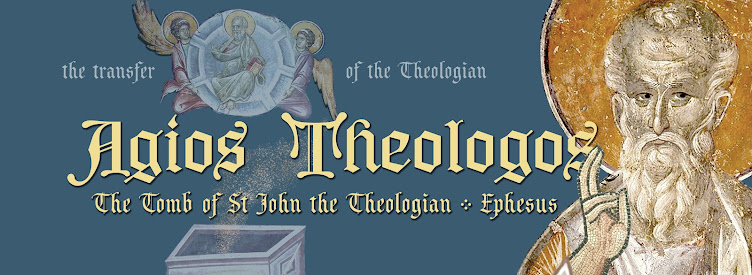Matushka Evfrosinia came equipped with her own knowledge and veneration of St. John, which enriched our time spent with her.
Monday, October 27, 2025
The Pilgrimage of Abbess Evfrosinia of Lesna
Thursday, October 16, 2025
The Holy Martyr Adauctus and His Daughter St. Callisthene of Ephesus
.jpg) |
| The Holy Martyr Adauctus of Ephesus, minature (10th c), Menaion of Vasilios II |
Adauctus was born in Ephesus and became the governor of his city during the reign of Emperor Maximian in the fourth century. When Emperor Maximian asked Adauctus for his daughter Callisthene's hand in marriage, Adauctus refused him, as he did not want his daughter to be the wife of a pagan idolater. Because of this, Adauctus was stripped of his position, his property was confiscated, and he was exiled to Melitene (Armenia), where he was beheaded Callisthene initially hid in Nicomedia, then traveled to Thrace (the northeastern part of the Balkan Peninsula), and settled with a woman whose daughter she healed from an eye ailment through prayer. After Maximian's death, Callisthene went to the wife of the new emperor Licinius Constantia, the sister of Emperor Constantine the Great, who was a Christian, and told her everything about herself. The queen lovingly received her and helped her regain her father's confiscated property from Maximian. Upon receiving her property back, Callisthene distributed it to the poor. She then transferred her father's holy body from the place of captivity in Melitene to Asia, in Ephesus. There, she built a temple in his memory and placed his holy relics in it. She spent the rest of her life in holy apostolic work and eventually reposed in the Lord.
Wednesday, October 15, 2025
The Appearance of St. John the Theologian to St. Andrew the Fool-for-Christ
 |
| Detail of the icon of St. Andrew the Fool-for-Christ with the hagiography: "Appearance of St. Apostle John the Theologian," iconographer Dionisije, 15th century, Russia. |
Excerpt from the Life of St. Andrew the Fool-for-Christ, Oct. 2 / Oct. 15.
And when it was about midnight, and the Saint was praying fervently to the Lord, the devil with a multitude of demons appeared openly before him: some of them held axes in their hands, some swords, some clubs, sticks, some scimitars and stones, some ropes. The demon with whom Andrew had been struggling also appeared, roaring against him from a distance, and rushed towards him with an axe in his hands to mutilate him. The other demons followed him. And the blessed Andrew, raising his hands, cried out with tears to the Lord, saying: "Lord, do not deliver the soul that glorifies Thee to the beasts!"
Tuesday, April 1, 2025
Pilgrimage Ampoules of St. John the Theologian
A Pilgrimage Blessing
The term a pilgrimage evlogia (Greek: ευλογια), a pilgrimage blessing, refers to a blessed object connected to a pilgrimage shrine.
From the first centuries of Christianity, a pilgrimage was a journey to a holy place which allowed the pilgrim to partake of the holiness of that place by physically being present there: simply put, to receive the blessing of that place. Ever pilgrim wished to take something away which was infused with the holiness of the place of pilgrimage, whether it be a fragment of relics, or more often, some object which was somehow connected to that place.
Thursday, February 20, 2025
A pilgrimage to a forgotten sacred region of Asia Minor
Saturday, February 15, 2025
DIVINE LITURGY AT MOUNT GALESION in the ruins of St. Lazarus’ monastery
A pilgrimage to a forgotten sacred place of Asia Minor
On the 20th of November (NS), AD 2024, when the Holy Church commemorates the memory of Venerable Father Lazarus of Galesion, Bishop Akakije of Uteshiteljevo, with the nuns of the Sepulcher Hermitage of St. John the Theologian celebrated the holy liturgy in the ruins of St. Lazarus’ monastery. This was a special occasion because no holy liturgy had been served here for centuries.
Mount Galesios is 15 km from Ephesus.
Produced by Bishop Akakije of Uteshiteljevo.
The Hermitage of the Sepulcher of St John the Theologian,
Selcuk (Ephesus), Turkey
Monday, February 3, 2025
The Symbol of Faith Revealed by St. John the Theologian
 |
| St. Gregory the Wonderworker of Neocaesarea, fresco from Studenica Monastery, Serbia, AD 1314 |
An excerpt from the life of St. Gregory the Wonderworker (+Nov. 17/30)
At that time arose the heresy of Savelius and Paul of Samosata (1). This heresy caused confusion about the Holy Spirit. St Gregory prayed earnestly to God and to the Theotokos that they reveal the true faith to him. One night, as he prayed with great fervor, the Most Pure Virgin Mary appeared, shining like the sun, accompanied by St. John the Theologian dressed in bishops’ vestments. The Most Pure Theotokos ordered St. John the Theologian to teach St. Gregory the mysteries of the Holy Trinity. St. John the Theologian obeyed the Theotokos and taught St. John the Theologian, for a short time, the great mysteries of God, revealing divine knowledge from inexhaustible depths of wisdom. The words of revelation spoken by St. John the Theologian were these:

.png)
